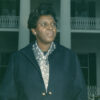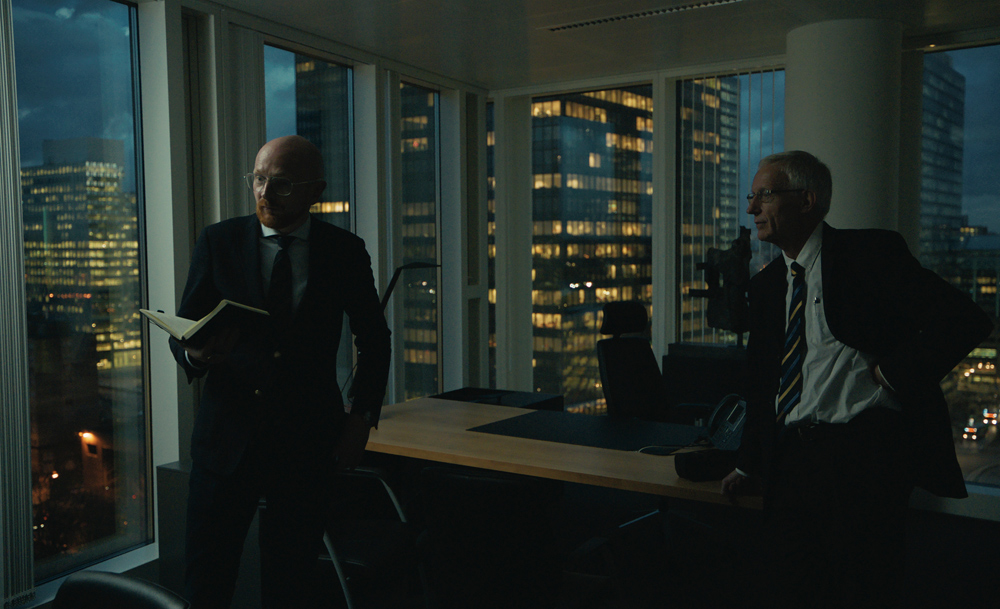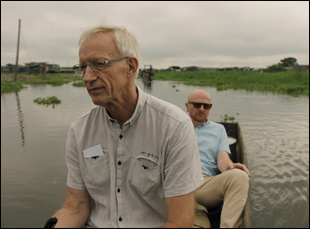It would seem to take a lot to shock Mads Brügger these days. Having snuck inside North Korea under the guise of being the manager for a sketch comedy duo to expose humanitarian horrors under the totalitarian regime for “The Red Chapel” and learning he could buy a Liberian ambassadorship that he could subsequently use to procure blood diamonds from the Central African Republic in “The Ambassador,” the filmmaker has long found situations so absurd you have trouble believing they’re true – and no one more than Brugger himself has encouraged that confusion more. Yet in “Cold Case Hammarskjöld,” Brugger comes across something so unbelievable that, even in his first film in which he never adopts an alias to push the story forward, he appears to drop any artifice completely in examining the plane crash of the late U.N. Secretary General Dag Hammarskjöld in 1961.
Unlike Brügger’s previous films, he is not driving the action in “Cold Case Hammarskjöld,” or even necessarily leading it, instead joining Göran Björkdahl, a former aid worker-turned-private investigator as he looks into the mysterious circumstances surrounding the crash as the aircraft carrying Hammarskjöld was heading over the Congo to achieve a cease-fire between U.N. troops and the Katanga, part of his mission in the region to maintain the progress made during the decolonization of Africa and prevent newly independent countries from falling back into old tyrannies. Stray elements from past investigations such as the plane being unguarded for two hours before take-off have led to considerable speculation and conspiracy theories as to how it happened, but Brügger and Björkdahl have success at pulling them together in uncovering potentially why, turning their attention to the work of white nationalist Keith Maxwell, the founder of the South African Institute for Maritime Research (SAIMR), a paramilitary organization fixated on decimating the black population.
This being a Brügger film, the filmmaker can’t help but wryly remark that the investigation “combine[s] all my interests — villains in white wear, Ace cards left at crime scenes and tracking down Belgian mercenaries,” and indulge in a provocative structure in which he dictates his findings to black secretaries in the comfort of a hotel room, but “Cold Case Hammarskjöld” becomes something quite sobering, raising troubling questions about how easily such deranged efforts such as SAIMR can achieve legitimacy, even if you can’t believe they were capable of hatching a plot to weaponize HIV, one of the more sensational claims made in the film by Maxwell’s associates. Following its premiere at Sundance earlier this year, where Brügger won the Best Director Prize in World Cinema Documentary, the film is set to blow minds across America beginning this week as it hits theaters and recently while he was in New York, the Danish provocateur spoke about changing gears with his latest film, the responsibility of deciding to include potentially incendiary claims and working on something that may ultimately be difficult to shake.
It began in 2011 or thereabouts with me reading a newspaper article about the work of Göran Björkdahl and how he was busy tracking down the remaining black witnesses [of the plane crash that killed Dag Hammarskjöld]. I invited Göran to come to Denmark to meet with me and I was curious to find out if he was a conspiracy theorist. I quickly discovered he is the very opposite. He’s very serious, very skeptical, very clear-minded, and also a very Swedish man — probably the most Swedish man I have ever met. He has a very gentle side to him, which I appreciate, so learning about his work, finding the black witnesses and also [learning] about the missile plate with the small hole in it [found in the plane] quickly made me realize there had to be a film in this. Also, I found enjoyment in the idea of two middle-aged Scandinavian guys setting out to prove that Hammarskjöld was the victim of a conspiracy to kill him. The stakes are very high. There’s a megalomania in it, which I like.
Given how many dead ends you encounter and put in, were you always sure there was a film?
We were working on a great many leads – a Romanian lead and a Russian lead and many of these leads turned out to be goose chases. A landmark moment and a true game changer in all of this was meeting the former head of military intelligence in South Africa because first of all, guys like these normally don’t give interviews and then him telling us, and he was absolutely convinced about this, that [Keith] Maxwell, in his opinion, was financed and directed by British intelligence, which is a very extraordinary piece of information, that made us in many ways totally reconsider our idea about Maxwell because up until that point, I was quite convinced that Maxwell was acting alone. The South African Maritime Research Institute was Maxwell’s creation and [I thought] that he was most likely a crazy person – dangerous, yes, but crazy and acting by himself in making these weird documents with clip out stationery and so on. But [with the former head of military intel] telling us about how he was convinced that Maxwell was a British agent totally turned it around and also made us realize that there had to be something in SAIMR that had to be taken seriously, and that in the shadows of this, something very dark and sinister was lurking.
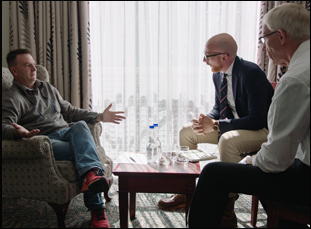
I saw no need for me to be in the film in my initial thoughts about how to construct the film, but I quickly realized that the only way to tell this story would be through a lot of narration to make sense of it all. This film is layered with and structured around hardcore journalism and it has been a very lengthy, time-consuming process. We were sitting on a mountain of research material that was piling up day by day, so having to find structure and meaning in all of this and also planning ahead was very different from my previous films. Then of course [one you decide on narration], you have to ask, “Well, who is the narrator going to be?” I found that in the name of transparency and also honesty that I should be the narrator and then I might as well be in the film also in a way.
Obviously, Göran had done his own research, but having navigated African bureaucracy before with “The Ambassador,” was it any easier to do your digging?
Of course having been in Africa before in many ways came in handy. A very resourceful tool in this film is we were working with a former South African policeman who has access to a database that contains the phone numbers of everyone in South Africa, and I mean everyone, which is a wonderful tool to have at hand as a journalist.
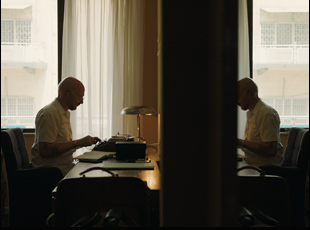
I thought long and hard about if to include this in the film or not and if so, how to do it. The very key to the film is when I say, “This could either be the world’s greatest murder mystery or the world’s most idiotic conspiracy theory.” Later on, when we encounter the the whistleblower of the film — Alexander Jones, a former member of the South African Maritime Research Institute, I emphasized to [him] not to offer any [testimony] that he doesn’t have photos/papers/personal effects proving that he took part in [with] SAIMR. I only say in the film what we know to be true which is that we know Maxwell was running a number of clinics, he was experimenting on black people – that is a fact. We also have the strategy papers of Maxwell where he writes about waging biological warfare on black people through the HIV virus, and then we have two former members of SAIMR – Jones and [the brother of] Dagmar Feil, who both had the experience of taking part in a sinister vaccination program. But this calls for much more investigation hopefully and preferably by a government actor in order to get full disclosure about what SAIMR really was about.
There are a couple points where you look visibly shaken in a way I hadn’t seen before in your previous films. Is it easy to stay shocked given all that you’ve seen?
What is highly disturbing and what stays with you for a long time is realizing that the South African Maritime Research Institute was an entity which was for real. That came as a shock and it’s like when you are a deep sea diver and you have to be in a decompression chamber for a while before you can enter the real world [again]. That is a feeling I brought back with me — I need some time for spending in a decompression chamber.
“Cold Case Hammarskjöld” opens on August 16th in limited release, including Los Angeles at the Alamo Drafthouse Downtown and the NoHo 7 and New York at the IFC Center. A full list of theaters and dates is here.



